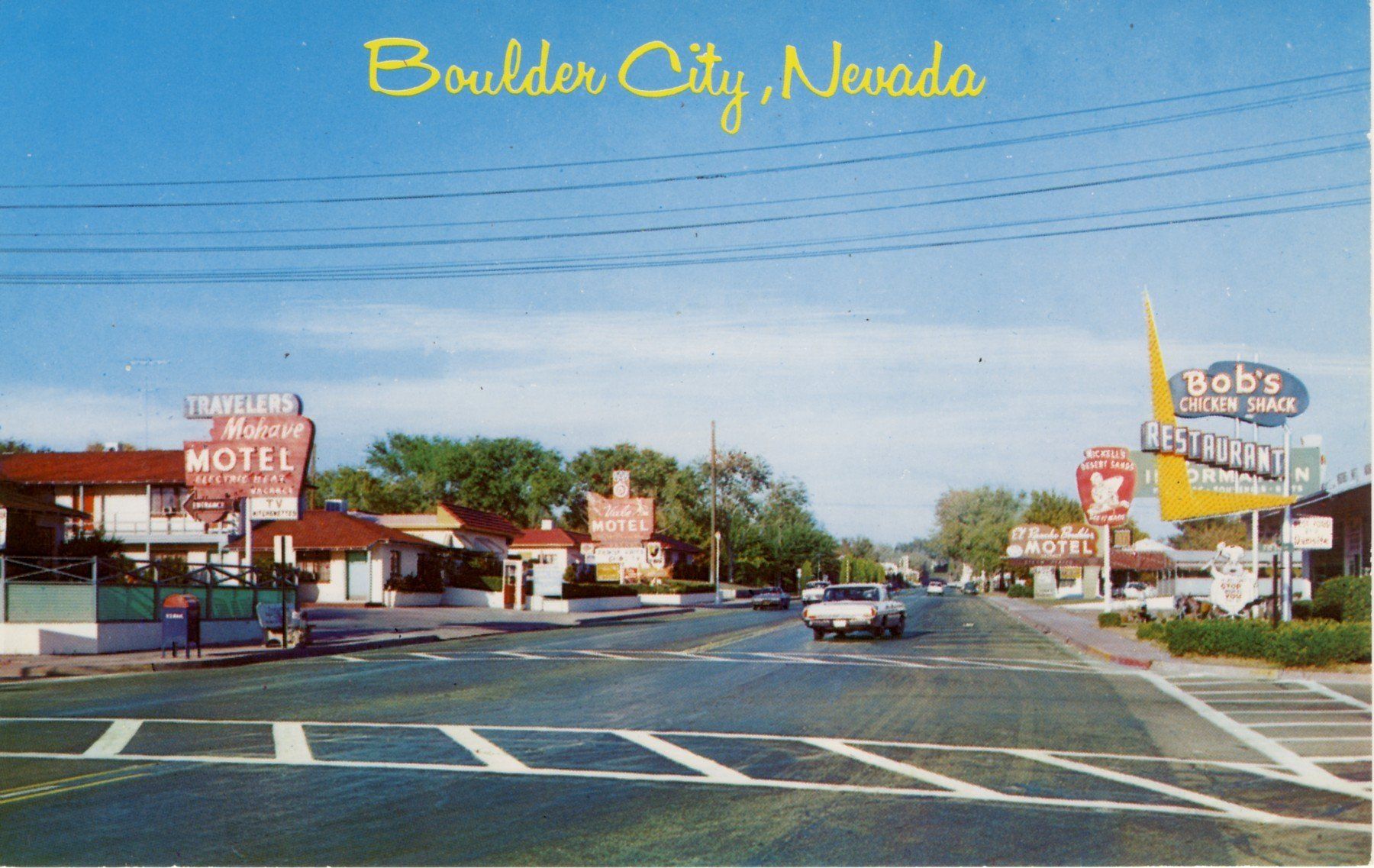LasVegas

Las Vegas - History
A confluence of events in the 1930s put Las Vegas on a path of cultural and economic change. Boulder Dam (later known as Hoover Dam ) started construction in 1930 and continued through 1936. In 1931 gambling was legalized in Las Vegas providing a magnetic form of entertainment. In that same year, the Nevada legislature liberalized its divorce laws shortening residency requirements from 3 months to just 6 weeks. And the automobile was becoming a more common means of travel.
Las Vegas was an important stop for automobile travelers. There were two main routes through Las Vegas. Highway 91 cut across Southern Nevada in a south-to-north trajectory. Once it crossed Fremont Street, it became the Arrowhead highway. The other way to Las Vegas was across Route 66 to Kingman, Arizona, then north crossing Hoover Dam, dropping down to the Boulder Highway and on to Fremont Street. Travelers who braved the heat and the wind to arrive at their destination were accommodated in small motels around Las Vegas. Along East Fremont street, on South and North Las Vegas Blvd, and downtown, blocks of independently-owned mom-and-pop motels sprang up.

South Las Vegas Blvd
Throughout the 1930s and 1940s, downtown was the center of the city’s growth. The “cottage court” motel design reflected an early form of vacationing by motorcar. These were built with cabins that had typically 2 units per cabin with well-kept grounds lush with green grass, beautiful flower beds, and shady trees. The shift from the cottage court to the “auto court” or “motor court” motel design is most typified by a new, more modern, in-line format of rooms under a common rooftop. These long, low, one-story buildings had the cost advantage of a shared air-conditioning plant, plumbing system, and foundation. Aesthetically, details such as gabled porch roofs highlighted each room as a separate entity, contributing to a homey feel for guests. Many of these early motels were on South Las Vegas Boulevard, the main highway into town from Los Angeles, leading directly to downtown.

East Fremont Street
By the 1950s, almost all motels had an identifying roadside sign, often of neon, and a strategically-placed swimming pool to lure travelers. In the 1950s a typical “row” motel had the office/manager’s unit located at the front closest to the street. Directly behind was a row of rooms in a single story building where you parked your car right outside your room. Others added a second story to the row motel. Here guests could still pull their cars up to the building with direct access from the parking lot to their room. The two story units had a balcony linking the rooms and overlooking the parking lot or the pool. The balcony railing gave a place for the motel to exhibit some decorative distinction.
East Fremont Street Motels

The Strip
The 1960s ushered in the Jet Age. Now vacationing was completely about the destination. In Las Vegas the tourist scene shifted away from downtown to The Strip on Las Vegas Boulevard south of Sahara Avenue. By the early 1970s the motel had morphed into a motor inn, motor lodge, and its box-like relation the highway hotel. The chain motel was dominant. These motels now had to offer more amenities such as an indoor pool, HBO, and game rooms. Characteristics included a main entry door, lobby, interior access to guestrooms, and often an indoor pool, recreation area, and restaurant. Common hallways provided a respite from weather extremes and were a desirable alternative to the exteriors entrances proffered by motels.

Downtown
Some motels and smaller hotels are located in the immediate downtown area amidst the downtown casinos.
Downtown Motels
Visit the longest continuously running hotel and casino in Las Vegas, the El Cortez Hotel and Casino
with its neon arrow, marquee, and signature large roof sign which are still downtown landmarks. On February 22, 2013, the building became the only existing casino to be placed on the National Register of Historic Places.

North Las Vegas Blvd
North of downtown Las Vegas where Main Street meets North Las Vegas Blvd there are more motels. This is now a quiet middle-class neighborhood. Not much Strip hustle. The old motels remaining are dispersed among the neighborhood buildings. The Neon Museum is also located just north of downtown (The Neon Museum Visitors’ Center is located inside the historic La Concha Motel lobby.)
North Las Vegas Blvd Motels

Boulder City, NV
Boulder City was originally built in 1931 as housing for workers who were building the Hoover Dam. The sheer scale of the dam and duration of the project required the Bureau of Reclamation to consider the construction of a semi-permanent town rather than a temporary arrangement. Boulder City was exceptionally rare as an example of a town fully planned under government supervision.
Boulder City Motels
The workers of Boulder City were under strict monitoring: alcohol was prohibited in the town and gambling has been prohibited since the city's outset.
The government did not relinquish control of Boulder City until 1959, when the town was incorporated. The city charter, approved by the residents, prohibited gambling within the city limits. This provision still exists, making Boulder City one of only two locations in Nevada where gambling is illegal. Alcohol sales were first permitted in 1969.
Boulder City has its own collection of attractive motels.
